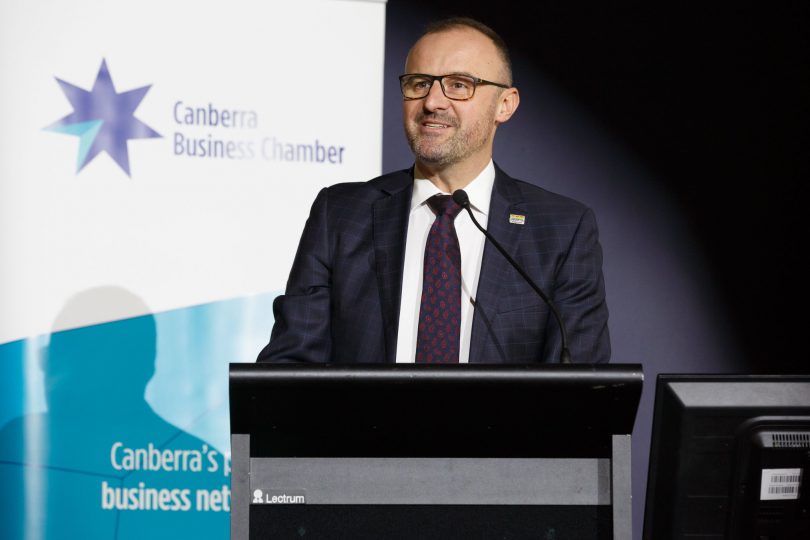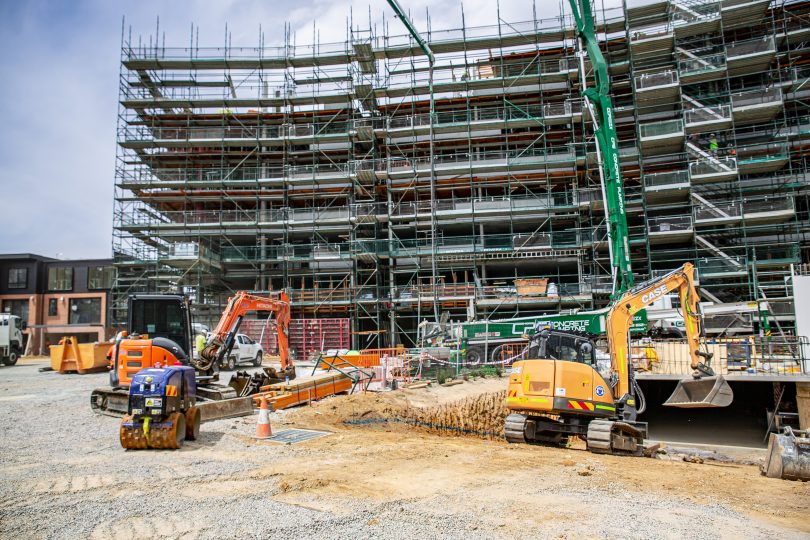
Chief Minister Andrew Barr has been touting the ACT’s private sector growth. Photo: Canberra Business Chamber.
Going into an election year, the latest economic forecast for the ACT would have Chief Minister Andrew Barr smiling at what could be seen as an endorsement of his government’s policy direction.
The Deloitte Access Economics Business Outlook for December calls the ACT the “little territory that could”, defying the national downturn and recording its largest-ever share of the national economy – 2.2 per cent.
The outlook says the “standout” ACT economy continues to buck the national trend and extend its stretch of bumper growth, anchored by the public sector and its stable employment, but also boosted by the rising private sector, where two-thirds of the jobs created since the beginning of 2016 reside.
It says Canberra’s labour market continues to be Australia’s star performer, with the lowest unemployment rate and strongest job growth across all the States and Territories, as well as a “sky high” vacancies list.
It’s contributing to a virtuous circle, with the ACT Government spending big on services such as health, education and housing as the national capital attracts new workers and the population continues to grow at an above-national rate.
The Canberra Liberals will argue that the price of that spending is record rates and charges, a position that will form the core of the Opposition’s strategy at the October election.
The ACT’s population growth, combined with high rents and low vacancy rates, has contributed to a housing crisis for the Territory’s low-income earners, and the report highlights that the government’s response includes a $100 million injection for public, community and affordable housing.
As well as more people wanting to work and settle in the ACT, the report says tourists and international students are coming in droves, helped by the lower Australian dollar.

Construction is down but is expected to pick up again by the middle of the year. Photo: Region Media.
It’s not all rosy, though. Wages, like the rest of Australia, are subdued and may remain so in the public sector amid the Federal Government’s public service shake-up and low-wage growth through EBAs, but the private sector may face wage pressures amid skills shortages.
As a result, consumers have cut back on their spending, although with their higher than average salaries, not as much as the rest of Australia, and lower interest rates are helping.
Also, housing construction is “on the backburner” with the completion of several big apartment projects, but this is expected to turn around by the middle of the year.
The outlook says engineering construction activity in the ACT has paused but the Territory budget has announced half a billion dollars for new capital works over the next four years, and more than a billion dollars for future capital works.
With light rail Stage 1 up and running, the overall investment spend in the Territory is “in a consolidation phase”, but the government is hoping for a start to light rail Stage 2A to Commonwealth Park by mid-year, and long-term there is light rail Stage 2B across the lake to Woden.
Commercial construction continues to cool with the $160 million ACT Law Courts project nearing completion and the $300 million Constitution Place mixed-use development expected to be finished by the middle of this year.
The $500 million redevelopment of the Australian War Memorial is due to begin late this year, and the Government is moving ahead with the $500 million Surgical Procedures, Interventional Radiology and Emergency Centre (SPIRE) expansion at Canberra Hospital.
However, the outlook says there could be lean times ahead for ACT commercial construction.
Overall, the negatives should not be overstated, it says.
“Like Australia more generally at the moment, there are headwinds, but the ACT remains in good shape to tackle these front on,” the outlook says.
Original Article published by Ian Bushnell on The RiotACT.


What's Your Opinion?